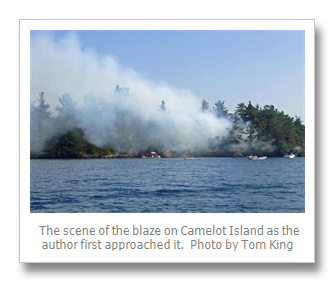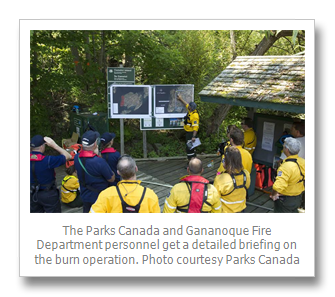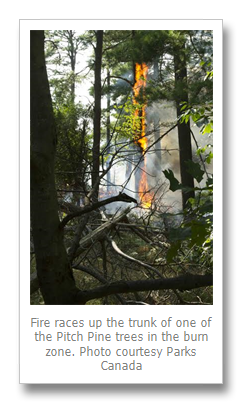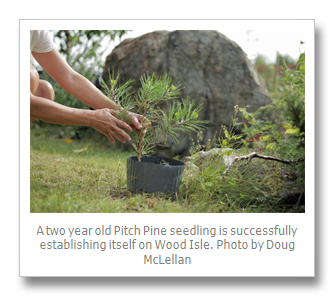Tuesday, July 22nd was a perfect day on the river – sunny and warm with a light wind blowing from the southwest. My buddy, Glenn, and I decided that we would take advantage of the idyllic conditions that afternoon by spending a couple of hours pursuing the increasingly elusive small mouth bass in some of our favourite fishing spots. Clearing the foot of Hay Island, on our way to the Jack Straw Shoal, we noticed a huge plume of white smoke, billowing into the sky near Grindstone Island. Being naturally curious, we put our fishing plans on hold and headed towards the scene of the fire. As we got closer it became obvious that the blaze was on Camelot, one of the Thousand Islands National Park islands. We wondered whether a boat had caught fire at the dock or if a carelessly discarded cigarette had ignited a wildfire.

Apparently, the conditions that day were exactly what Parks Canada had been waiting for too and what we were witnessing on Camelot Island was actually a controlled fire being performed to clear away some of the organic material on the forest floor and to open-up the canopy to improve the germination and growing conditions for the Pitch Pine trees, located in the burn zone.
Parks Canada, on their website, explains the reasoning for the “prescribed fires”. “The suppression of natural fire by human intervention over a number of decades has removed a natural process, integral to the biodiversity and health of the mixed forest of the Thousand Islands region.
Research into the forest fire history of the Thousand Islands region has revealed that there have been far fewer and smaller fires in the Thousand Islands region since the arrival of European settlers than in the centuries before. For many decades, it was expected that all efforts would be made to prevent and extinguish forest fires in the park. Suppression of fire, which has been a natural and essential process for the health of mixed forests located within the Thousand Islands region, has created an additional stressor to the ecosystem’s biodiversity and health. The fire will stimulate new growth, and offer new habitat opportunities for a variety of species.” [1] [2]

The crew at Parks Canada had been planning the prescribed fire on Camelot Island, for about three years, waiting for the ideal conditions to all align at the same time. Parks Canada spokesman Bruce MacMillan described the parameters that had to be in place before the operation could be undertaken as, “the right temperature, humidity and wind direction combined with ideal fuel conditions”.
When it was announced that the Camelot Island burn could finally proceed, the sixteen member Parks Canada team, under the guidance of Thousand Islands National Park Superintendent Jeff Leggo, sprang into action. The 1.06 hectare area that was to be burned was divided into five separate zones and a fire break was established between the target area and the rest of the island. On the day of the fire the island was closed to visitors, and after a thorough briefing to make sure everyone understood what was going to take place, the personnel on the ground began the ignition process.

Starting on the north-west shore and moving in a southerly direction to take advantage of the wind the crews ignited the thick layer of organic material on the forest floor with drip torches. In order to properly manage the operation, each zone was allowed to burn down completely before the next one was set on fire in what is known as a looping ignition pattern. With the ground cover being tinder dry, it ignited very easily and the fire spread quickly. Every few minutes the bright orange flames would race to the top of one of the trees like a giant torch, making a loud crackling sound as it did so. Members of the Gananoque Fire Department were closely monitoring the burn from their fire boat and would quickly soak any of the trees that ignited or areas that looked like they were starting to burn too intensely. It took a little over three hours to perform the burn and everyone involved was in agreement that it was a success.
The Camelot Island fire is the fourth “prescribed fire” that Parks Canada has conducted in the past five years. “In 2009, Parks Canada fire crews performed a restoration fire on Georgina Island. In 2010, the park initiated a fire on Gordon Island, and in 2011, fire was successfully used to restore part of the park’s mainland property at Mallorytown Landing”. [1]
According to Mr. Leggo the past fires have already shown the desired benefits. “We got a lot of seed regeneration,” he said in reference to the fire on Georgina Island. “They started coming up pretty quickly”. Since the Pitch Pine seeds don’t typically last for more than a year, after they leave the cone, their regeneration after the fire is from freshly dropped seeds enjoying the perfect new conditions, pointed out Park Ecologist Josh Van Wieren.
The primary target of the “prescribed fire” on Camelot Island was the stand of about fifty mature Pitch Pine trees. Parks Canada states that “Pitch Pine is a rare species of tree in Canada, only known to be found in Leeds County and in a small area in Quebec. It has been an emblematic tree in representing the scenic beauty of the Thousand Islands. As a result of the park’s prescribed fires, more Pitch Pine and Red Oak seedlings have been counted since monitoring began in the early 1970s”. [1]
This type of pine tree is not as rare in the United States and, in the words of the USDA Forestry Service, they “grow over a wide geographical range-from central Maine to New York, south to Virginia and southern Ohio and in the mountains of eastern Tennessee, northern Georgia, and western South Carolina. Because it grows mostly on the poorer soils, its distribution is spotty. In the Northeast, Pitch Pine is most common on the sandy soils of Cape Cod, Long Island, south-eastern New Jersey and in some sections of sandy or shallow soils in Pennsylvania”. [3]
Since the Pitch Pine trees are shade intolerant it is important to reduce the amount of overhead forest canopy, created by other species of trees, to allow the precious sunlight to shine in. The reduction of the canopy is one of the primary objectives of the Parks Canada fires. The other is to remove the thick layer of organic material or “duff” on the forest floor to expose the granite soil that the Pitch Pine seeds require to germinate. Although many of the Pitch Pines, located near the core of their range, require the heat from a fire to open the cones, this isn’t actually the case for the trees in the Thousand Islands, according to Mr. Van Wieren. “Their cones almost always open each year, without fire (although heat can speed up the opening process).”

The name “Pitch Pine” was derived from the fact that this species of tree has a very high resin content. Uses for the Pitch Pine wood, in the “olden days”, included, waterwheels, gates and flumes, dock pilings and even fence posts - any place where rot resistant wood was required. Also, the pitch was rendered down to make "tar" for His Majesty's Navy at Kingston and the wood burned to produce charcoal for the local blacksmiths.
In Canada, there is currently no commercial use made of the wood. There is limited commercial use in the eastern United States. This is mainly due to the fact that Pitch Pines grow slowly and quite crooked on the windswept rocky isles of the 1000 Islands and on the rocky ridges of the Frontenac Arch; on deeper, well drained soil they grow tall and straight and these were the trees that the Loyalist settlers cut and used. Reference material from the North Carolina State University also mentioned that, “Early American settlers would often ignite pine knots for torches. Before the widespread use of the southern pines for naval stores, Pitch Pine was used in the United States for the production of turpentine and rosin”.[4]

Meanwhile, working away in relative obscurity, on his own mission to preserve the local Pitch Pines, is Gananoque native Doug Bickerton. Since 2006 Doug has been harvesting Pitch Pine cones each fall, for the purpose of growing new seedlings. Over the years Mr. Bickerton has fine-tuned his “grow-op” process, which includes a high temperature baking cycle to simulate the natural forest fires, to obtain a good yield of seedlings in each batch. In 2014 Doug gave a little over 500 seedlings to Park Canada and a further 650 are now going out to local residents in the Islands, back lakes and along the ridges of the Frontenac Arch. As Doug said, "That's the limit of my grow-op."[5]
Doug is quick to point out the fact that the Pitch Pine is the Town of Gananoque’s official tree and is well worth preserving. Being a life-long tree enthusiast he is also painfully aware of the fact that the local population of this particular species has declined by about forty percent, since the late 1960s, due to a host of reasons. It is estimated that there are approximately 20,000 Pitch Pine trees remaining in the area, and of those, about 10 percent have been grown from Doug’s seedlings. Although this year’s seedlings are already spoken for, Doug is more than happy to add anyone who is interested in obtaining some, to his waiting list. Doug Bickerton can be reached at 613-382-5187.

Just a short distance up river from the site of the Parks Canada “prescribed fire” on Camelot Island are several of the Bickerton “babies”. In 2012 Doug McLellan and Caroline Yung, who own Wood Isle, obtained some of the young trees and planted them in accordance with Mr. Bickerton’s specific guidelines. Two years later they are happy to report that the Pitch Pines are doing well and are hoping that many years in the future, they will have grown tall and acquired the iconic windswept shape, so familiar in the Thousand Islands, that comes from the relentless exposure to the prevailing south-westerly winds.
With the continuing efforts by people such as Jeff Leggo and the Parks Canada staff, Doug Bickerton, and Doug McLellan and Caroline Yung, the future of the Thousand Islands Pitch Pines looks very promising indeed.
By Tom King
Tom King and his wife Marion have lived in Milton, Ontario for the past 28 years, where they both worked and raised their family of three children; Kris, Mike and Becca. Tom still has a strong attachment to the Thousand Islands, having grown up in Gananoque and being a “river rat” from a very early age. The family tries to return to the islands every summer and for the past several years have been renting a cottage on Sampson (a.k.a. Heritage) Island, just out from Gananoque.
Editor’s note: The King family is well known in the region as the “J.W. King Water Filtration Plant”, which stands on the shore of the St. Lawrence Rive,r in the Gananoque Marina Basin, was named after Tom’s father, in recognition of the contributions that he made to the upgrading of the Town’s water system, while acting as Chairman of the P.U.C. Click here to see all of Tom’s articles.